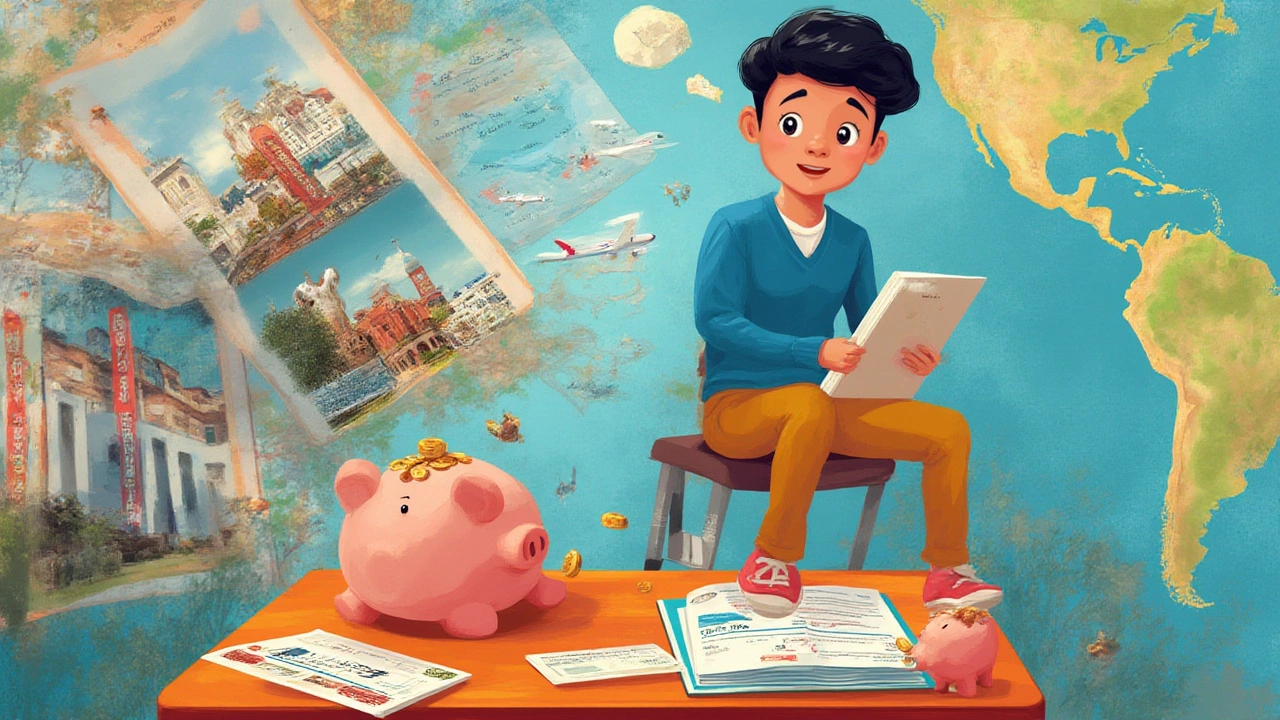
Picture this: packing a suitcase, learning to order coffee in another language, posting selfies from Paris or Seoul. But before your adventure begins, you keep circling back to the big question: study abroad – can it actually be free? Sure, you might have heard about German universities with zero tuition, or Scandinavian countries rumored to hand out scholarships like confetti. But is it smoke, mirrors, or genuine opportunity? People chase this dream for different reasons, but no one wants it turning into a financial nightmare. The truth is, yes, some students get a nearly free ride—but grabbing that ticket takes grit, research, and a willingness to hunt for options that most people never hear about. So, how does the game really work?
The Honest Costs of Studying Abroad: What 'Free' Really Means
When folks say “study abroad is free,” they’re usually talking about tuition. Germany is famous for public universities charging zero euros for undergrad studies—even to international students. Norway opens university doors without tuition fees for everyone, regardless of passport. Sounds like magic, right? But ‘free’ is never the full picture. Let’s break it down. Tuition is just one slice of the pie. You’ll still need to pay for rent, food, health insurance, plane tickets, books, maybe even visa fees and, oh yes, occasional weekend trips to wander around castles or volcanoes. If you’re after a handout for every single expense, the answer is a hard no. Most places will expect you to prove you’ve got money for daily life. For example, Germany asks international students to show about €11,208 a year (roughly NZ$20,000 at current rates) sits somewhere handy before granting a student visa. So yes, you could escape tuition—but you still need solid savings or help for daily life.
What about the big English-speaking destinations like the US, UK, Australia, or Canada? Free tuition’s almost impossible unless you land a full-ride scholarship or a government program. Tuition fees can run from NZ$25,000 right up to NZ$60,000 per year, especially for top-ranked universities. Even master’s programs in places like New Zealand mostly demand international students pay full price. There are rare cases: Norway’s fully free tuition for all evaporated in 2023 for outside EU/EEA students, shocking lots of hopefuls. Sometimes, countries introduce free-tuition policies for their own nationals but not outsiders, and these can change with a snap. Always double-check official university sites—don’t just believe viral TikToks or Reddit threads, since rules shift quickly.
Yes, there are countries with lower overall costs. Taiwan, Mexico, and Argentina have decent universities with affordable living. A few places might combine moderate tuition with low prices for housing and food, making the package cheaper than studying at home. If you’re willing to learn in the local language, even more doors open. A 2024 survey from UNESCO showed that the average spend by international students in Europe for one academic year (tuition plus living) was about €14,000, while it rocketed over US$40,000 in North America. Realistically, ‘free’ means you’ll still need a budget—just maybe smaller than you’d expect.
Countries and Universities That Offer (Almost) Free Education
Ready for the shortlist? Germany consistently tops the list. Their public universities boast zero tuition fees for undergraduates, even if you aren’t from Europe. Some master’s programs are free too, but if you study in English, you might pay small administration or semester fees (€200-€350 per term, giving you a public transit ticket). Then there’s France—public universities charge just a few hundred euros per year, with extra help for students who ace the paperwork. Look out for Grandes Écoles and elite programs, as those cost far more. Austria, Finland, Czech Republic, and Poland offer affordable options, especially if you can tackle your degree in the local language.
More highlights: Argentina’s public universities are free for everyone, but courses are exclusively in Spanish. Tuition at top-ranked Mexican universities can be under NZ$1,500 a year. Hungary’s universities often pair moderate fees with well-funded scholarships, and Taiwan draws in students with tons of English-language courses and a low cost of living—rent plus food might be under NZ$500 a month in some cities.
Is there a catch? Sometimes yes—competition. The high-status fully-funded scholarships at top German, Dutch, or Swedish universities require great academic records, quirky motivation letters, references, and sometimes language tests. Scandinavian universities love offering English-taught programs, but from 2023, Sweden and Finland reintroduced tuition fees for non-European students (often NZ$12,000–NZ$22,000 per year). There are exceptions: a lucky few win government-backed scholarships like the Erasmus Mundus Joint Master’s Degree (thousands of applicants, only a handful of spots), French Eiffel Scholarships, or the DAAD for Germany. These usually cover tuition plus a monthly stipend for rent and food, but you need to craft a killer application and tick all eligibility boxes.
Some European countries let you work part-time legally during studies—Germany and France, for example, both allow around 20 hours per week. Student jobs can pay enough to fund basics, but expect minimum wage and lots of competition. If you try landing in a country without speaking the local language, it can be tough to find work quickly. Still, combining several strategies—a tuition-free university, a small scholarship for rent, odd jobs, and careful budgeting—can shave off thousands from your expenses.
| Country | Public Tuition Fees (Int'l) | Living Costs (per year) | Notes |
|---|---|---|---|
| Germany | €0 (undergrad) | €11,208+ | Student visa requires proof of funds |
| France | €277 - €3,770 | €12,000+ | French-taught programs cheapest |
| Argentina | Free | NZ$7,000+ | Mainly in Spanish |
| Mexico | NZ$500 – $1,500 | NZ$6,000+ | Low costs, Spanish often required |
| Finland | €8,000-€18,000 | €10,000+ | Some scholarships for non-EU |
| Netherlands | €6,000-€20,000 | €12,000+ | High for popular courses |
| Czech Republic | Free (Czech); €3,000+ (English) | €7,000+ | Cheaper in Czech-only degrees |

Scholarships, Grants, and Secret Strategies for Cheap Study Abroad
Bills getting you down? Scholarships come to the rescue. They fall into several buckets: government-funded (think New Zealand Aid Programme, Australia Awards), university-specific (like the Auckland University International Student Excellence), and quirky third-party grants (try The Fulbright Program or Rotary International). Some pay full tuition, others give you a monthly allowance, sometimes you get both. The kicker? Competition is fierce. Everyone wants a golden ticket, so your application needs more than just good marks. Add volunteering, unique projects, leadership roles, or winning competitions to your CV. Don’t sleep on deadlines—big scholarships may close as much as a year before courses begin.
For Kiwis, the Prime Minister’s Scholarship for Asia gets plenty of buzz, sending students on funded exchanges. The British Chevening Scholarship or the Japanese MEXT are hot tickets for citizens of dozens of countries. US universities hand out loot through need- or merit-based aid, though usually, the best awards go to postgrads. In Europe, Erasmus+ exchanges offer monthly stipends and even pay part of your travel costs for short study periods. A 2024 DAAD report showed their average scholarship to students in Germany was €934 per month—enough to scrape by with a shared flat and supermarket meals.
- Tip: Always look for scholarships at three levels: national, university, and department. Some less-hyped awards run for specific degrees or niche subjects (think ‘Best Essay on Water Conservation’).
- Tip: Smaller countries or little-known institutions often get fewer applicants. Don’t be afraid to skip the Ivy League and try something off the radar.
- Tip: Don’t miss out on local funding. Many embassies or businesses help students from their region—Audacious? Sure. Effective? Often, yes.
Need even more ways to save? Watch out for accommodation hacks. France’s CROUS and Germany’s Studentenwerk provide subsidized student apartments, sometimes just €250 a month (if you apply super early). Carve cash off your meal budget by cooking at home—local markets always beat eating out. Get a student transport pass, which slashes local travel costs to a third of regular fares. Sign up for university-run buddy programmes—locals often help newcomers with cheap housing finds or tips on ‘free food’ nights.
Part-time jobs can stretch your funds, but stack up your hours carefully. In many countries, your student visa limits work to 15–20 hours per week. New Zealand now lets students work up to 20 hours a week, which is a big help since minimum wage is currently NZ$22.70 per hour. Sweden’s more flexible, and lets you work as much as you want (though studies come first). Remember: the hunt for a job in a foreign country is never instant—you’ll need grit, local contacts, and a good cover letter. Try university job boards, cafes, and anything with ‘student’ in the name.
Unexpected Challenges and Real Tips for Study Abroad Hopefuls
Even if you bag a ‘free’ deal, it won’t all be crepes and cheers. The first shock? Visa and paperwork stress. Bureaucracy in Germany, France, or South Korea can be legendary: require bank statements, insurance, possibly a police check, and proof of accommodation before you even land. Stack up your savings—sometimes embassies demand proof of up to NZ$25,000 to cover a year’s living costs. The process usually isn’t in perfect English, so double-check every line and ask for help from former students through Facebook groups or Reddit. Don’t underestimate the time this takes; some folks have waited months for one missing document.
Culture shock is real, even for hardened travelers. In Japan, landing without Japanese skills will make official paperwork, apartment hunting, and even ordering at restaurants a hassle. Even European universities have unique quirks: German professors rarely use email or don’t reply; French institutions love paper forms with impossible stamps. Many countries don’t include textbooks in tuition, so budget at least NZ$200–$500 per semester.
When budgeting, double what you think you’ll need for the first few months. Even the best-laid plans can get smashed by currency swings, bank fees, an unplanned medical appointment, or that must-have winter coat you never needed back home in Wellington. Always check for student discounts; in almost every country, flashing your student card gets you cheaper transit, entry to museums, or mobile phone deals. Above all: talk to other students. The savviest tips on free bank accounts, affordable SIM cards, and even secret supermarket discounts come from people in the trenches rather than glossy brochures.
Lastly, think beyond money. Your time overseas should teach you more than academics. Employers love evidence of resilience, flexibility, and language skills, as these often beat another line on your transcript. Don’t shy away from small cities or lesser-known universities—they can be just as friendly and might mean cheaper rent, lower tuition, and fewer tourists. If you do your homework, chase every funding angle, and keep your expectations realistic, the world isn’t as locked down by price tags as you think. Adventure, new friendships, and memories you’ll laugh about in 20 years? Priceless.
More Articles

How to Create a Course Online for Free: Your No-Cost Launchpad
This article walks you through making and launching your own online course without spending a single penny. It covers the best free tools, setting up lessons, sharing your content, and smart ways to attract learners. If you're ready to teach what you know, this guide will help you skip the confusing stuff and actually get started. Expect honest tips, facts, and a straightforward approach to building your e-learning space. You'll even learn how to stand out in a crowded market.

Best Tests for Studying in the USA: Your Guide to Success
Navigating the path to studying in the USA often begins with selecting the right standardized test. The SAT, ACT, and TOEFL are key players in this decision, each catering to different aspects of a student's abilities and language skills. Understanding the nuances of each exam and how they align with your strengths can make all the difference. In this guide, we'll demystify these tests, offering practical tips to boost preparation and performance. Make an informed choice that paves the way for your academic journey in the USA.

eLearning vs Classroom Learning: What Really Sets Them Apart?
Ever wondered what truly makes eLearning different from classroom learning? This article breaks down the unique benefits, hurdles, and experiences of each approach. From flexibility and tech requirements to the real-life impact on staying motivated, you’ll see how both stack up. If you’re picking a learning path or just curious, you’ll find practical insights and tips right here. No fluff—just what you need to know.
